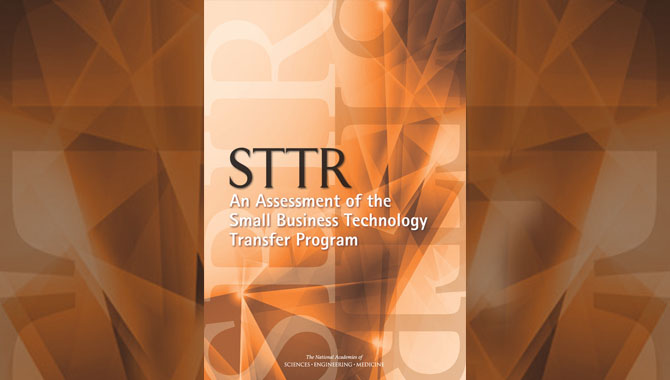
A recent National Academies report assessed the Small Business Technology Transfer (STTR) program, which advances technology through the support of NASA and other federal agencies.
As a partner to the larger Small Business Innovation Research (SBIR) program, the STTR stimulates technological innovation by promoting formal collaborations between small business concerns (SBCs) and non-profit research institutions (RIs). Through the STTR, which was instituted in 1992, NASA and four other government agencies—the Department of Defense (DoD), the National Institutes of Health (NIH), the Department of Energy (DoE), and the National Science Foundation (NSF)—offer competitive awards that encourage research, or research and development (R&D), via partnerships between small-scale private industry and academia. Typically, the competitive awards support early-stage, high-risk R&D.
According to a new report from the National Academies of Sciences, Engineering, and Medicine, not all agencies employ the STTR in the same way. NASA and DoD are considered “acquisition agencies”: each strategically uses the STTR to encourage the creation of new products and processes that will actively meet the needs of the agency. Their goal is to sponsor the development of innovative technologies that the agency can purchase and infuse into projects. In this way, NASA and DoD employ the STTR as a critical resource for driving the exploration and potential development of cutting-edge technologies within RIs. This differs from the approach taken by “grant agencies,” such as the DoE, NIH, and NSF. These agencies usually fund R&D that is in line with their missions, but don’t seek to acquire the end products.
At NASA, centers heavily influence STTR topics and awards. Each Center Chief Technologist (CCT) helps develop STTR topics that address center project needs. These topics typically support defined technology areas within the agency’s Space Technology Roadmaps. After proposals based on these topics are received from interested small business/research organization partners, the CCT and Technology Infusion Manager (TIM) review and prioritize the proposals, providing recommendations to the agency’s STTR/SBIR Program Executive. This helps ensure that the STTR program supports the agency’s projects and missions.
In 2011, Congress renewed the STTR and SBIR programs for six more years with the understanding that the National Academies would review both programs. The resulting report, STTR: An Assessment of the Small Business Technology Transfer Program, determined that the STTR does effectively meet its objectives of fostering partnerships between SBCs and RIs and disseminating the resulting knowledge. However, some barriers to successful collaboration remain a concern:
- Formal collaboration between RIs and SBCs is challenging. RIs are committed to the development and dissemination of technical knowledge, whereas small businesses are focused on commercializing that knowledge, which often includes restricting its dissemination through patents or other means. This inherent conflict between approaches can complicate cooperation.
- Issues surrounding the ownership of intellectual property (IP) may be sensitive. In particular, RI specifications regarding IP can delay the contracting agreement process.
- The specific role of the STTR versus the SBIR can be confusing. Federal agencies that use the STTR most successfully have a clear strategic focus for STTR grants that is distinct from SBIR awards.
To address the above challenges, the National Academies recommend several steps. First, funding agencies and grant recipients should utilize the Small Business Administration (SBA), when needed, to resolve issues of contractual delays or problems with deliverables. Second, SBC and RI partners should seek out the most effective models for royalty and licensing schemes—which may differ from the RI’s existing model—and then further tailor these templates to suit their particular projects. Finally, funding agencies should identify a strategic role for the STTR as distinct from the SBIR. NASA and DoD have found that focusing STTR awards on products that are at an earlier technological readiness level (TRL) is often effective.
The FY 2016 NASA STTR awards will be announced on April 28, 2016.
Read the full report: STTR: An Assessment of the Small Business Technology Transfer Program.
Visit the NASA SBIR/STTR website to learn more.









